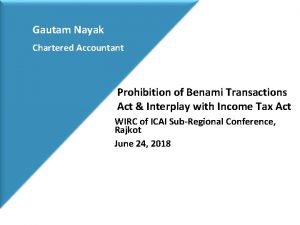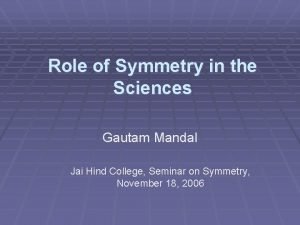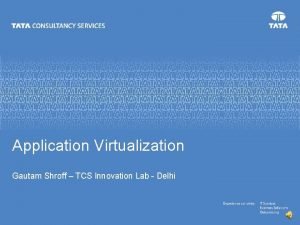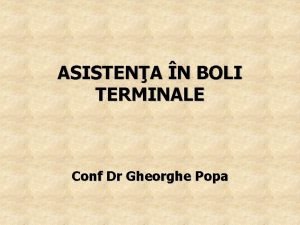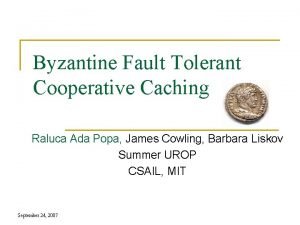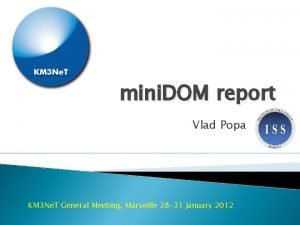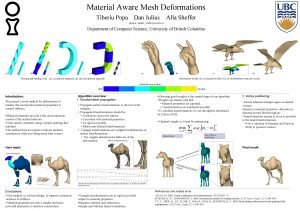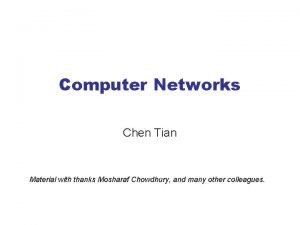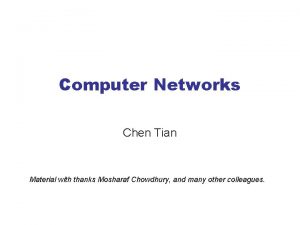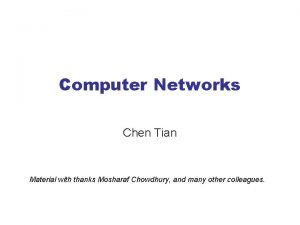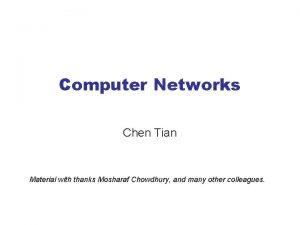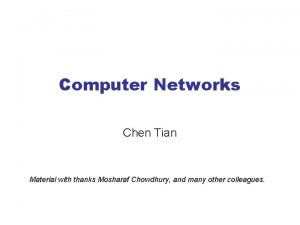Sharing Cloud Networks Lucian Popa Gautam Kumar Mosharaf























- Slides: 23

Sharing Cloud Networks Lucian Popa, Gautam Kumar, Mosharaf Chowdhury Arvind Krishnamurthy, Sylvia Ratnasamy, Ion Stoica UC Berkeley

State of the Cloud Network? ? ? 2

Guess the Share TCP Per flow 3: 1 Per Source 1: 1 Per Destination 2: 1 Per-VM Proportional 3: 2 A 1 A 3 B 1 B 2 Link L Alice : Bob = ? : ? 3

Challenges Network share of a virtual machine (VM) V depends on » Collocated VMs, » Placement of destination VMs, and » Cross-traffic on each link used by V Network differs from CPU or RAM » Distributed resource » Usage attribution (source, destination, or both? ) Traditional link sharing concepts needs rethinking 4

Requirements Min Bandwidth Guarantee Introduce performance predictability Aggregate Proportionality Network shares proportional to the number of VMs High Utilization Do not leave bandwidth unused if there is demand 5

Requirement 1: Guaranteed Minimum B/W Provides a minimum b/w guarantee for each VM Captures the desire of tenants to get performance isolation for their applications Bmin. A A B Bmin. X … X All VMs 6

Requirement 2: Aggregate Proportionality Shares network resources across tenants in proportion to the number of their VMs Captures payment-proportionality » Similar to other resources like CPU, RAM etc. Desirable properties » Strategy-proofness: Allocations cannot be gamed » Symmetry: Reversing directions of flows does not change allocation 7

Design Space Min Bandwidth Guarantee Symmetry Aggregate Proportionality High Utilization Strategy. Proofness 8

Requirement 3: High Utilization Provides incentives such that throughput is only constrained by the network capacity » Not by the inefficiency of the allocation or by disincentivizing users to send traffic Desirable properties » Work Conservation: Full utilization of bottleneck links » Independence: Independent allocation of one VM’s traffic across independent paths 9

Design Space Tradeoff 1 Min Bandwidth Guarantee Symmetry Aggregate Proportionality Strategy. Proofness Independence High Utilization Work Conservation 10

Tradeoff 1: Min B/W vs. Proportionality A 1 B 1 C/2 C/3 2 C/3 C/2 Link L with Capacity C A 2 B 3 Share of Tenant A can decrease arbitrarily! 11

Design Space Tradeoff 2 Tradeoff 1 Min Bandwidth Guarantee Symmetry Aggregate Proportionality Strategy. Proofness Independence High Utilization Work Conservation 12

Tradeoff 2: Proportionality vs. Utilization A 1 A 2 C/4 A 3 B 1 B 3 A 4 C/4 C/4 Link L with Capacity C B 2 B 4 To maintain proportionality, equal amount of traffic must be moved from A 1 -A 2 to A 1 -A 3 => Underutilization of A 1 -A 3 13

Per-link Proportionality Restrict to congested links only Share of a tenant on a congested link is proportional to the number of its VMs sending traffic on that link 14

Per Endpoint Sharing (PES) Five identical VMs (with unit weights) sharing a Link L A 2 A 1 A 3 B 1 B 2 Link L 15

Per Endpoint Sharing (PES) Resulting weights of the three flows: NA = 2 A 1 B 1 3/2 A 2 3/2 A 3 2 B 2 Link L To generalize, weight of a flow A-B on link L is . . 16

Per Endpoint Sharing (PES) Symmetric WA WB + = WB-A WA-B = NA NB Proportional » sum of weights of flows of a tenant on a link L = sum of weights of its VMs communicating on that link Work Conserving Independent Strategy-proof on congested links 17

Generalized PES L A Scale weight of A by α B Scale weight of B by β WA WB WA-B = WB-A= α +β NA NB α > β if L is more important to A than to B (e. g. , A’s access link) 18

One-Sided PES (OSPES) L A Scale weight of A by α B Scale weight of B by β WA WB WA-B = WB-A= α +β NA NB Per Source closer to source Highest B/W Guarantee Per Destination closer to destination α = 1, β = 0 if A is closer to L α = 0, β = 1 if B is closer to L *In the Hose Model 19

Comparison Link Proportionality Per Flow Per Source Static Reservation Link PES OSPES § Symmetry ✓ ✗ ✓ ✓ ✓ § Strategy-Proofness ✗ ✓ ✓ Utilization § Independence ✓ ✓ ✓ § Work Conservation ✓ ✓ ✗ ✓ ✓ B/W Guarantee 20

Aggregate Bandwidth Full-bisection B/W Network 1000 900 800 700 600 500 400 300 200 100 0 Tenant 1 Tenant 2 Per. Flow Per. Source Link PES Network OSPES Tenant 1 has one-to-one communication pattern Tenant 2 has all-to-all communication pattern Ideal 21

Map. Reduce Workload Aggregate Bandwidth 3000 2500 Tenant 1 Tenant 2 Tenant 3 2000 1500 1000 500 0 Per Flow Per Source Link PES Network OSPES Optimal W 1: W 2: W 3: W 4: W 5 = 1: 2: 3: 4: 5 22

Summary Sharing cloud networks is all about making tradeoffs » Min b/w guarantee VS Proportionality » Proportionality VS Utilization Desired solution is not obvious » Depends on several conflicting requirements and properties » Influenced by the end goal 23
 Mosharaf chowdhury
Mosharaf chowdhury Sanjay gautam nayak
Sanjay gautam nayak Joshua kretchmer
Joshua kretchmer Gautam venugopalan
Gautam venugopalan Dipendra gautam
Dipendra gautam Gautam mandal tifr
Gautam mandal tifr Gautam menon imsc
Gautam menon imsc Gautam shroff tcs
Gautam shroff tcs Gautam das uta
Gautam das uta Dr gautam goswami
Dr gautam goswami Why do you feel proud of mt everest and gautam buddha
Why do you feel proud of mt everest and gautam buddha Datagram network
Datagram network Basestore iptv
Basestore iptv Anna tcherkassof
Anna tcherkassof Gheorghe popa medic
Gheorghe popa medic Isabela delia popa
Isabela delia popa Raluca ada popa
Raluca ada popa Domreport
Domreport Medic sinucis
Medic sinucis Ruxandra popa
Ruxandra popa Tiberiu popa arrested
Tiberiu popa arrested Tiberiu popa
Tiberiu popa Tiberiu popa ploiesti
Tiberiu popa ploiesti Vasko popa patka tekst
Vasko popa patka tekst

